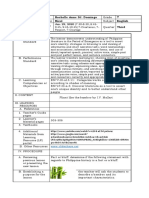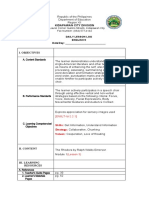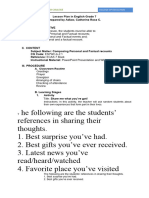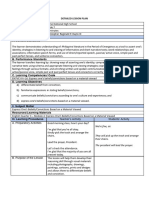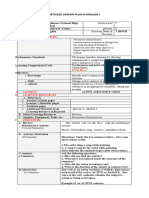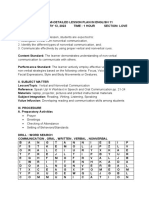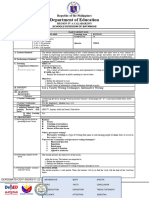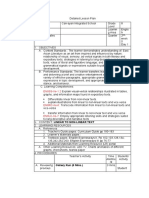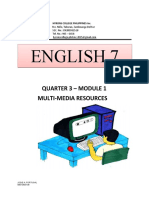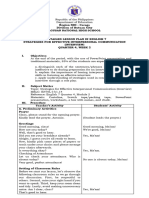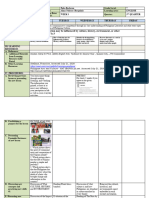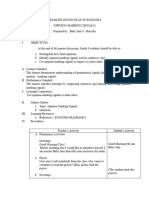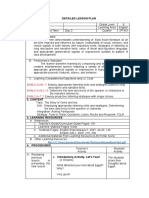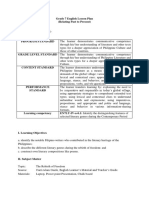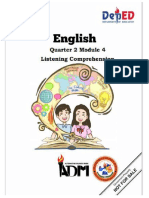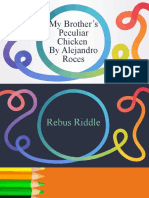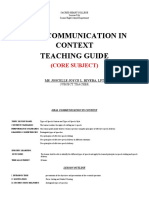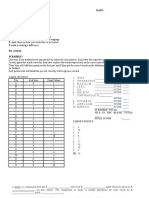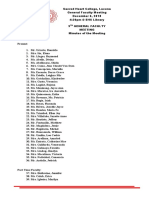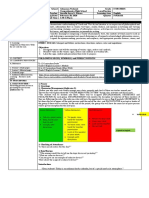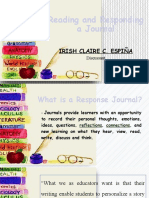GODBLESS Lesson Exemplar G7 JJLR English 2nd COT JJLR
Uploaded by
Joscelle Joyce RiveraGODBLESS Lesson Exemplar G7 JJLR English 2nd COT JJLR
Uploaded by
Joscelle Joyce RiveraLearning Area English Grade Seven-JJLR
Learning Delivery Modality Modular Distance Modality (Learners-led Modality)
School ATIMONAN NCHS Grade Level Grade Seven
LESSON Teacher MS. JOSCELLE JOYCE L. Learning Area English
EXEMPLAR RIVERA
Teaching Date May 20, 2021 Quarter Third Quarter
Teacher‘s Time Tuesday, 2:00-3:00 pm No. of Days 1 day
I. OBJECTIVES • Identify figures of speech that show comparison (simile, metaphor,
personification) used in a given poem;
• Appreciate the use of figures of speech in poetry by determining the
literary element in a poem;
• Manifest the value of sharing one’s similarities and enjoying one’s
differences through the use of quotations;
• Use figure of speech in their own writing.
A. Content The learner….
Standards demonstrates understanding of: Philippine literature during the Period of
Apprenticeship as a means of examining conflicts; various purposeful listening
and viewing strategies; difference between literal and figurative language; ways
to extract and condense information based on library sources; verbal and non-
verbal cues in oral communication; and types of phrases, clauses, and
sentences.
B. Performance The learner…
Standards transfers learning by: resolving conflicts presented in literary selections; using tools
and mechanisms in locating library resources; extracting information and noting
details from texts to write a précis, summary, or paraphrase; distinguishing
between and using literal and figurative language and verbal and non-verbal
cues; use phrases, clauses, and sentences meaningfully and appropriately.
C. Most Essential EN7LT-IV-h-3: Explain how a selection may be influence by culture, history,
Learning environment, or other factors.
Competencies
(MELCs)
D. Enabling • Identify the distinguishing features of revolutionary songs, poem, short
Competencies stories, drama and novels;
(If available, • Discover literature as tool to assert one’s unique identify and to better
write the understand other people.
attached
enabling
competencies)
II. CONTENT Use of Figures of Speech that show comparison
III. LEARNING Learner’s Packet (LeaP) English Week 4 Third Quarter
RESOURCES
A. References
a. Teacher’s
Guide Pages
b. Learner’s
Material Pages
c. Textbook Dumlao, M.C. (2000). Communication for Progress. Quezon City: Watana Phanit
Pages Printing and Publishing Co., LTD.
d. Additional
Materials from
Learning
Resources
B. List of Learning
Resources for
Development
and
1|P age
Engagement
Activities
IV. PROCEDURES
Preliminaries Daily Routine
A. Prayer/Welcome Greetings
B. Checking of Attendance
C. Rules
I- nspire others to do their best.
D- o not hesitate to ask.
E-liminate all negativity and be proactive.
N-ever give up.
T- hink first, before you do/say something.
I-nteract with everyone using the English language.
T- reat others on how you would like to be treated.
Y-earn in making a difference.
A. Introduction What I need to know?
The learners will be given an idea of the competencies they are expected to
learn and to comprehend about the objectives of the lesson.
• Identify figures of speech that show comparison (simile, metaphor,
personification) used in a given poem;
• Appreciate the use of figures of speech in poetry by determining the
literary element in a poem;
• Manifest the value of sharing one’s similarities and enjoying one’s
differences through the use of quotations;
• Use figure of speech in their own writing.
Indicator #1: What’s new?
Subject
Integration Pre-Activity
(under the topic:
INDOOR SCRABBLE!
RECREATIONAL Direction: Each student has to unscramble the letters for each number. Each
ACTIVITIES in letter has respective points.
Physical As they guess the words correctly, they have to place the words respectively on
Education the correct part of the given definitions.
Grade 8) Then, they will add their points on the first part and if they put the correct words
on the definition for the second part, their points will be doubled.
First person who will finish the pre-test correctly will be given a reward.
Legend:
I. Answers:
Tile Point Values 1. Two
Indicator #1: A 1 2. Different
Subject B 3 3. Similar
integration C 3 4. Like
(Mathematics D 2 5. As
subject in E 1 6. Direct
counting the
F 4 7. Comparison
scores)
G 2 8. Objects
H 4 9. Animals
I 1 10. Human
J 8 II. Answers:
K 5 A simile is a comparison
L 1 between two objects of different
kinds which are however similar
M 3
in one respect. The comparison
N 1
in simile is usually introduced by
O 1
such words as like and as.
P 3
2|P age
Q 10
R 1 A metaphor is an implied simile. It is
S 1 direct comparison of the two
T 1 objects as if they are one and the
U 1 same.
V 4
W 4 Personification is a figure of speech
X 8 in which objects and animals are
Y 4 given human qualities.
Z 10
B. Development What I Know?
The teacher uses ACTIVITY
CONTENT-BASED The students are given an activity which will introduce them about the topic
INTRUCTION to be discussed.
(4A’s Activity-
Analysis, This is an activity that would measure how fast your brain works, and at the same
Abstraction, time, would display your inner musical skills.
Application)
Indicator #1: Task 1: GUESS THE “TOOT”
Subject Instructions:
Integration 1. You are going to pick a word inside the container (bowl or box).
(Music) The words are:
• She/she’s
• Song
• I
• Rock or island
• Teach/dance
2. You need to think of a song that has that word (that you picked) in its
lyrics.
3. You need to sing the song but, you have to replace the word that you’ve
picked with “toot”.
4. Both the one who’ll guess the word correctly and the player will receive
a reward.
(The words given above, are the keywords from the lyrics of the songs with SIMILE,
METAPHOR and PERSONIFICATION)
What’s In?
ANALYSIS
The learners are given questions to help them link the previous activity with the
present topic.
Directions: Read the following sentences/lyrics and take note of the underlined
phrases.
1. She’s like a song, played again and again.- Replay by Sean Kingston
(simile)
2. I am a rock, I am an island. – I am Rock by Simon and Garfunkel
(Metaphor)
3. Fireflies tried to teach me how to dance.- Fireflies by The Owl City
(Personification)
Answer the following questions:
1. What two items are being compared in sentence 1 and 2?
2. What words or expressions are used to compare them?
3. How about number 3, who teach someone how to dance?
4. Do you think fireflies could teach a person how to dance?
5. How does the underlined phrases make a sentence more meaningful?
3|P age
What is It?
ABSTRACTION
Let’s Talk About It
The learners are now given a brief discussion of the lesson and help them to
discover and understand new concepts/skills.
Read the poem below:
First, A Poem Must Be Magical
By Jose Garcia Villa
First, a poem must be magical,
Then as musical as a seagull.
It must be a brightness moving
And hold secret a bird’s flowering
It must be as slender as a bell,
And it must hold fire as well.
It must have the wisdom of bows
And it must kneel like a rose.
It must be able to hear
The luminance of dove and deer.
It must be able to hide
What it seeks, like a bride.
And over all I would like to hover
God, smiling from the poem’s cover.
“Many writers, in composing poems and prose, use language that is not literal
but which represent things, actions, and ideas. Such language includes figures
of speech that enhance meaning and imaginative quality of poems and prose.
“Notice that, as you read it, you’ll see how writers use figurative language to
add beauty and creativity in poems. It adds color, vigor, and effectivity to a
writer’s style particularly in poetry.”
The most commonly used figures of speech are the simile, metaphor, and
personification. Let us have these figures of speech.”
Figurative language gives clearness, force, and beauty to ideas and adds
effectiveness to one’s speech and writing. Figurative language uses figures of
speech. A figure of speech is any use of words in a sense different from their
literal definition. Let us have the most common figures of speech that shows
comparison:
(The teacher will tackle first examples for each figures of speech to be able for
the student/s to come up with the meaning.)
4|P age
Direct
comparison
of two
objects as if
they are one
and the
same.
“Since poetry is a literature that appeals to the imagination, a poet makes use
of literary elements that influence culture, history, environment, or other factors.
That stimulate his/her readers to think and imagine his/her subject.”
C. Engagement What’s more?
The Formative APPLY
Assessment is
now The teacher will give an independent activity that would solidify their
administered by understanding or skill of the topic.
the teacher.
Learning Task 1: PICK ME UP!
Directions: Pick out the figure of speech in the poem.
same activity is I Am Proud To Be A Filipino
given for those Toribia Maño
learners at home I am a Filipino.
using the printed I came from islands rippled with sun
module who do Where days are green fires and nights are warm
not have access With moon and stars. Girdling my loins is blood rich as milk
to internet or For I was born of sultans, rajahs, kings,
gadget to use. Soldiers, heroes who fought to sing
The poetry of freedom. My house is my land
Virgin, brown, wombed out of loam, volcanic rock and shells,
Carpeted with rice, corn, coconut, cane, trees
That rise as temples to grapple winds
Rains, mighty rivers furrowing the earth.
Where I walk, my shadow is a marriage of flags
Malay, Chinese, Spanish, American, Japanese
While in my bones sleep quietly as a bride
Vanquished desires of conquerors who dreamt of empires,
Gold, trade and spice. Though a paly breed
I stand with the ancients for my love and loyalty
Are as fish to the sea. I am proud of my brownness,
My duty and destiny are thirty-million brown men
Planting rice, husking coconut, throwing nets far into the Pacific
Hacking mountains of iron, coal, chrome, manganese and timber
To live. We are one and the same. A moving, restless caravan.
Indicator #1: What I can Do?
Subject
Integration/ Learning Task 2: GO FIGURE!
Localization Instruction: The teacher will show pictures of the eco-tourism spots in Atimonan/
(Araling Quezon Province. The students will create as many figures of speech that they
Panlipunan) can in describing the given eco-tourism spots.
Example: TAAL VOLCANO
Manong’s ice cream cone is as perfect as the shape of Taal Volcano. (simile)
5|P age
same activity is The Taal Volcano is a perfect-shaped cone. (metaphor)
given for those Taal Volcano angrily bursts and melts the grasses down. (personification)
learners at home
using the printed
module who do
not have access
to internet or
gadget to use.
D. Assimilation What I have learned?
Indicator #3: APPLICATION
The students
inside the The students will be given questions to be answered to process what they
classroom will learned from the lesson.
use Google
Form in
answering this Learning Task 3: DIG MORE!
activity. (link: Direction: Read the following expressions from the poem “I am Proud to be a
http://forms.gle/
P6wJCYuzRJe7t6 Filipino” and indicate whether it is a simile, metaphor, or personification.
WG8) Write your answers on your paper.
1. Girdling my loins is blood rich as a milk. Simile
(ICT integration)
2. Mighty rivers are furrowing the earth. Metaphor
while
3. My house is my land. Metaphor
same activity is 4. Trees rise as temples. Simile
given for those
5. Trees grapple with winds. Personification
learners at home
using the printed 6. Life is a dream. Metaphor
module who do
7. The white mares of the moon rush along the sky. Personification
not have access
to internet or 8. The wind tapped like a tired man. Simile
gadget to use.
9. His speech is like a whisper of a thousand bees. Simile
10. He is a lion in a fight. Metaphor
What can I do?
The teacher will provide an activity which will transfer their knowledge or skill into
real-life situation.
Indicator #1: Individual Activity
Value Task 2: FIGURES OF CHAINS!
integration (ESP) Directions: Group yourselves into three (3) and write three statements that would
emphasize how recognizing the beauty in others lessen or avoid
bullying in school or community. The three (3) statements should
comprise of one simile, one for metaphor and another one for
personification and put these on the chain below.
Example: I will build a strong friendship with them just like a chain. (simile)
Indicator #2:
Remember that
bullying
includes
differently-
6|P age
abled or
disabled Refer to RA 10627 or Anti-
individuals Bullying Act in connection
and persons of with this activity.
different Questions:
sexual
orientation 1. How did you use figures of
and gender speech in your sentence?
identity. (Refer 2. How do you treat other
to RA 10627 or people who are different
Anti-Bullying from you?
Act)
3. What does this say
regarding your attitude
towards other?
RUBRIC:
5 4 3
Very good Good Developing
Cleanliness The output is free The work has 3-5 The output has
from erasures erasures. more than five
and is erasures.
presentable/
readable.
Mechanics Make use of Make use of Punctuation,
correct correct spelling and
punctuation, punctuation, grammar slightly
spelling and spelling and distract the
grammar with grammar with reader. There are
less than five less than seven ten errors or less.
errors. errors.
Content/Message Content shows Content shows Content show
the correct use of two correct use none to one
figures of speech. of figures of correct use of
Its message is speech. It is quite figures of speech.
inviting and appealing and
encouraging. encouraging.
V. REFLECTION The learners will write their insights about the lesson.
Indicator #3: CLOSURE
The students will Create your own quotation which has the same thought as this quote, “share
post this task on our similarities, celebrate our difference.” -M. Scott Peck.
their Facebook Write your own quotation inside a one (1)
wall. Also, they
puzzle piece. Afterwards, you and
will make use of
camera in your classmates will fit your puzzle
taking a shot of pieces together in one large
their “quotation display, take a photo of it and share
puzzle”. it on your Facebook wall. Make sure
(ICT Integration) to tag your friends, your family or
your teacher to spread awareness
same activity is
regarding respect to individual
given for those
learners at home differences.
using the printed
module who do Guide in making your quotation:
not have access How can we share our similarities? How can we enjoy our differences to others?
to internet or
gadget to use.
7|P age
Indicator #1:
Value
Integration in
sharing
similarities and
respecting
differences.
(ESP integration)
Prepared by:
JOSCELLE JOYCE L. RIVERA
Teacher I
Checked:
HERBERT N. DOCE
Master Teacher II
Approved:
MERCEDES R. INFANTE
Head Teacher III, English Department
8|P age
You might also like
- English 7: Summative Test No. 1 Lessons 1 & 2 Listening Strategies & Locating Specific Sources100% (2)English 7: Summative Test No. 1 Lessons 1 & 2 Listening Strategies & Locating Specific Sources2 pages
- Dazai, Osamu - Self-Portraits ( Kodansha, 1991 )100% (3)Dazai, Osamu - Self-Portraits ( Kodansha, 1991 )231 pages
- Unfinished Determine The Worth of Ideas Mentioned in The Text Listened ToNo ratings yetUnfinished Determine The Worth of Ideas Mentioned in The Text Listened To14 pages
- Lesson Plan On Transcoding Linear and Non-Linear Texts - Grade 8 - University of Southeastern PhilippinesNo ratings yetLesson Plan On Transcoding Linear and Non-Linear Texts - Grade 8 - University of Southeastern Philippines16 pages
- Kidapawan City Division: J.P. Laurel Corner Quirino Streets, Kidapawan City Fax Number: (064) 577-4144No ratings yetKidapawan City Division: J.P. Laurel Corner Quirino Streets, Kidapawan City Fax Number: (064) 577-41445 pages
- Daily Lesson Log in English X: (En10Ss-Iid-3.11:)No ratings yetDaily Lesson Log in English X: (En10Ss-Iid-3.11:)6 pages
- 4th Quarter COT Internal Coflict External ConflictNo ratings yet4th Quarter COT Internal Coflict External Conflict5 pages
- Use The Passive and Active Voice Meaningfully in Varied Contexts (EN7G-III-c-2)No ratings yetUse The Passive and Active Voice Meaningfully in Varied Contexts (EN7G-III-c-2)4 pages
- Week 6-Quarter 4 - Discover Literature As A Tool To Assert One's Unique Identity and To Better Understand Other PeopleNo ratings yetWeek 6-Quarter 4 - Discover Literature As A Tool To Assert One's Unique Identity and To Better Understand Other People3 pages
- DETAILED-LP-grade 7 Mulitimedia ResourcesNo ratings yetDETAILED-LP-grade 7 Mulitimedia Resources6 pages
- LP CO2 - LINEAR AND NON-LINEAR TEXT (2021-2022) Final100% (2)LP CO2 - LINEAR AND NON-LINEAR TEXT (2021-2022) Final4 pages
- DETAILED LESSON PLAN IN ENGLISH 7-Week 3No ratings yetDETAILED LESSON PLAN IN ENGLISH 7-Week 33 pages
- Daily Lesson Plan in English Grade 7: 3rd QUARTER S.Y. 2021-2022100% (1)Daily Lesson Plan in English Grade 7: 3rd QUARTER S.Y. 2021-20222 pages
- Transcoding From Linear To Non Linear TextNo ratings yetTranscoding From Linear To Non Linear Text2 pages
- En8Lt-Iiid-2.2: En8Rc-Iiid-12: En8Rc-Iiie-2.1.7No ratings yetEn8Lt-Iiid-2.2: En8Rc-Iiid-12: En8Rc-Iiie-2.1.78 pages
- Detailed Lesson Plan in English (4a's Approach) Grade 10No ratings yetDetailed Lesson Plan in English (4a's Approach) Grade 109 pages
- React On What Is Asserted LP EDITED AND FINAL To Be Printed100% (3)React On What Is Asserted LP EDITED AND FINAL To Be Printed8 pages
- Analyzing Non-Linear Texts - Representing and Summarizing InformationNo ratings yetAnalyzing Non-Linear Texts - Representing and Summarizing Information2 pages
- English 7: Quarter 3 - Module 1 Multi-Media ResourcesNo ratings yetEnglish 7: Quarter 3 - Module 1 Multi-Media Resources5 pages
- I. Objectives: School: Grade Level: Learning Area: ENGLISH Quarter: TeacherNo ratings yetI. Objectives: School: Grade Level: Learning Area: ENGLISH Quarter: Teacher4 pages
- Strategies For Conducting An Effective Interview - OlaezNo ratings yetStrategies For Conducting An Effective Interview - Olaez11 pages
- Competency: Raise Sensible, Challenging Thought-Provoking Questions in Public Forums/panel DiscussionNo ratings yetCompetency: Raise Sensible, Challenging Thought-Provoking Questions in Public Forums/panel Discussion3 pages
- Get Information That Can Be Used in Everyday Life From News Reports, Speeches, Informative Talks, Panel Discussions, Etc.No ratings yetGet Information That Can Be Used in Everyday Life From News Reports, Speeches, Informative Talks, Panel Discussions, Etc.4 pages
- NLC23 - Grade 8 Enhancement English Notes To Teachers - FinalNo ratings yetNLC23 - Grade 8 Enhancement English Notes To Teachers - Final23 pages
- Explain How A Selection May Be Influenced by Culture, History, Environment, or OtherNo ratings yetExplain How A Selection May Be Influenced by Culture, History, Environment, or Other4 pages
- Edited Detailed Lesson Plan in English 8 1No ratings yetEdited Detailed Lesson Plan in English 8 18 pages
- Detailed Lesson Plan in English 7: I. Objectives100% (1)Detailed Lesson Plan in English 7: I. Objectives4 pages
- Grade 7 3rd To 4th Grading Learner's MaterialsNo ratings yetGrade 7 3rd To 4th Grading Learner's Materials258 pages
- GODBLESS Lesson Exemplar G7 JJLR English 2nd COT JJLRNo ratings yetGODBLESS Lesson Exemplar G7 JJLR English 2nd COT JJLR7 pages
- Lesson 4 and 5 Salutation To The Dawn and Indonesian LiteratureNo ratings yetLesson 4 and 5 Salutation To The Dawn and Indonesian Literature43 pages
- Orca Share Media1674510062896 7023404254847266209No ratings yetOrca Share Media1674510062896 70234042548472662094 pages
- Classroom Instruction Delivery Alignment MapNo ratings yetClassroom Instruction Delivery Alignment Map3 pages
- My Brother's Peculiar Chicken by Alejandro RocesNo ratings yetMy Brother's Peculiar Chicken by Alejandro Roces52 pages
- Grade 7 Group Screening Test: Comprehension CheckNo ratings yetGrade 7 Group Screening Test: Comprehension Check26 pages
- Goodevening!: Lesson 1 Introduction To LiteratureNo ratings yetGoodevening!: Lesson 1 Introduction To Literature82 pages
- Classroom Instruction Delivery Alignment PlanNo ratings yetClassroom Instruction Delivery Alignment Plan4 pages
- GODBLESS Lesson-Exemplar-G7-SSC-Speech-1st-COT-JJLRNo ratings yetGODBLESS Lesson-Exemplar-G7-SSC-Speech-1st-COT-JJLR8 pages
- I. Objectives: Kto12 Curriculum Daily Lesson Log For Demo TeachingNo ratings yetI. Objectives: Kto12 Curriculum Daily Lesson Log For Demo Teaching5 pages
- Name: Date: Grade and Section: Pre-ActivityNo ratings yetName: Date: Grade and Section: Pre-Activity7 pages
- Learning Area Learning Delivery Modality School Grade Level Teacher Learning Area Teaching Date Quarter Teacher S Time No. of DaysNo ratings yetLearning Area Learning Delivery Modality School Grade Level Teacher Learning Area Teaching Date Quarter Teacher S Time No. of Days4 pages
- Before Beginning This Lesson Students Should Be Able ToNo ratings yetBefore Beginning This Lesson Students Should Be Able To10 pages
- A. The Background of The Twenty-First CenturyNo ratings yetA. The Background of The Twenty-First Century58 pages
- Get Teaching Climate Change in the Humanities 1st Edition Stephen Siperstein (Editor) free all chaptersNo ratings yetGet Teaching Climate Change in the Humanities 1st Edition Stephen Siperstein (Editor) free all chapters45 pages
- Validasi Peserta Didik Smas Methodist 8 Medan 2021-01-14 12-18-41No ratings yetValidasi Peserta Didik Smas Methodist 8 Medan 2021-01-14 12-18-4163 pages
- Assignment - American Literature: My Father'S Tears - John UpdikeNo ratings yetAssignment - American Literature: My Father'S Tears - John Updike2 pages
- Conchitina R. Cruz - The (Mis) Education of The Filipino Writer, The Tiempo Age and Institutionalized Creative Writing in The Philippines (Final)No ratings yetConchitina R. Cruz - The (Mis) Education of The Filipino Writer, The Tiempo Age and Institutionalized Creative Writing in The Philippines (Final)32 pages
- Download ebooks file Writing War Corinne J. Saunders all chapters100% (10)Download ebooks file Writing War Corinne J. Saunders all chapters60 pages
- Reading Jibanananda Dass Banalata Sen From A Surr PDFNo ratings yetReading Jibanananda Dass Banalata Sen From A Surr PDF11 pages
- Impersonal Si Constructions Agreement And Interpretation Roberta Dalessandro pdf downloadNo ratings yetImpersonal Si Constructions Agreement And Interpretation Roberta Dalessandro pdf download86 pages
- Bruns (2012) - 'What's in A Mirror - James Joyce's Phenomenology of Perception'No ratings yetBruns (2012) - 'What's in A Mirror - James Joyce's Phenomenology of Perception'17 pages
- This Content Downloaded From 134.220.1.139 On Fri, 26 May 2023 22:18:13 +00:00No ratings yetThis Content Downloaded From 134.220.1.139 On Fri, 26 May 2023 22:18:13 +00:004 pages

